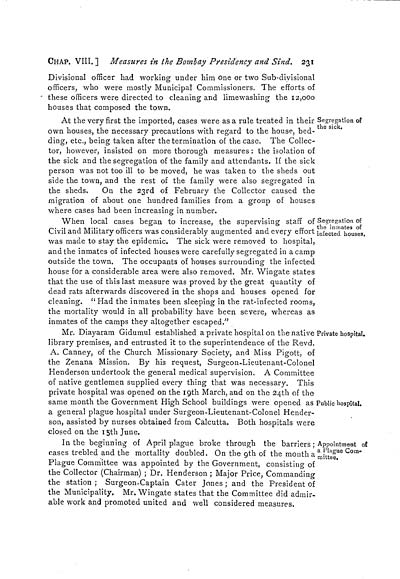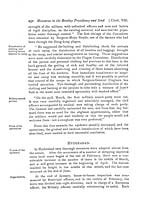Medicine - Disease > Plague in India, 1896, 1897 > Volume 1
(252) Page 231
Download files
Individual page:
Thumbnail gallery: Grid view | List view

CHAP. VIII.] Measures in the Bombay Presidency and Sind. 231
Divisional officer had working under him one or two Sub-divisional
officers, who were mostly Municipal Commissioners. The efforts of
these officers were directed to cleaning and limewashing the 12,000
houses that composed the town.
Segregation of
the sick.
At the very first the imported, cases were as a rule treated in their
own houses, the necessary precautions with regard to the house, bed-
ding, etc., being taken after the termination of the case. The Collec-
tor, however, insisted on more thorough measures: the isolation of
the sick and the segregation of the family and attendants. If the sick
person was not too ill to be moved, he was taken to the sheds out
side the town, and the rest of the family were also segregated in
the sheds. On the 23rd of February the Collector caused the
migration of about one hundred families from a group of houses
where cases had been increasing in number.
Segregation of
the inmates of
infected houses.
When local cases began to increase, the supervising staff of
Civil and Military officers was considerably augmented and every effort
was made to stay the epidemic. The sick were removed to hospital,
and the inmates of infected houses were carefully segregated in a camp
outside the town. The occupants of houses surrounding the infected
house for a considerable area were also removed. Mr. Wingate states
that the use of this last measure was proved by the great quantity of
dead rats afterwards discovered in the shops and houses opened for
cleaning. " Had the inmates been sleeping in the rat-infected rooms,
the mortality would in all probability have been severe, whereas as
inmates of the camps they altogether escaped."
Private hospital.
Public hospital.
Mr. Diayaram Gidumul established a private hospital on the native
library premises, and entrusted it to the superintendence of the Revd.
A. Canney, of the Church Missionary Society, and Miss Pigott, of
the Zenana Mission. By his request, Surgeon-Lieutenant-Colonel
Henderson undertook the general medical supervision. A Committee
of native gentlemen supplied every thing that was necessary. This
private hospital was opened on the 19th March, and on the 24th of the
same month the Government High School buildings were opened as
a general plague hospital under Surgeon-Lieutenant-Colonel Hender-
son, assisted by nurses obtained from Calcutta. Both hospitals were
closed on the 15th June.
Appointment of
a Plague Com-
mittee,
In the beginning of April plague broke through the barriers;
cases trebled and the mortality doubled. On the 9th of the month a
Plague Committee was appointed by the Government, consisting of
the Collector (Chairman); Dr. Henderson; Major Price, Commanding
the station; Surgeon-Captain Cater Jones; and the President of
the Municipality. Mr. Wingate states that the Committee did admir-
able work and promoted united and well considered measures.
Divisional officer had working under him one or two Sub-divisional
officers, who were mostly Municipal Commissioners. The efforts of
these officers were directed to cleaning and limewashing the 12,000
houses that composed the town.
Segregation of
the sick.
At the very first the imported, cases were as a rule treated in their
own houses, the necessary precautions with regard to the house, bed-
ding, etc., being taken after the termination of the case. The Collec-
tor, however, insisted on more thorough measures: the isolation of
the sick and the segregation of the family and attendants. If the sick
person was not too ill to be moved, he was taken to the sheds out
side the town, and the rest of the family were also segregated in
the sheds. On the 23rd of February the Collector caused the
migration of about one hundred families from a group of houses
where cases had been increasing in number.
Segregation of
the inmates of
infected houses.
When local cases began to increase, the supervising staff of
Civil and Military officers was considerably augmented and every effort
was made to stay the epidemic. The sick were removed to hospital,
and the inmates of infected houses were carefully segregated in a camp
outside the town. The occupants of houses surrounding the infected
house for a considerable area were also removed. Mr. Wingate states
that the use of this last measure was proved by the great quantity of
dead rats afterwards discovered in the shops and houses opened for
cleaning. " Had the inmates been sleeping in the rat-infected rooms,
the mortality would in all probability have been severe, whereas as
inmates of the camps they altogether escaped."
Private hospital.
Public hospital.
Mr. Diayaram Gidumul established a private hospital on the native
library premises, and entrusted it to the superintendence of the Revd.
A. Canney, of the Church Missionary Society, and Miss Pigott, of
the Zenana Mission. By his request, Surgeon-Lieutenant-Colonel
Henderson undertook the general medical supervision. A Committee
of native gentlemen supplied every thing that was necessary. This
private hospital was opened on the 19th March, and on the 24th of the
same month the Government High School buildings were opened as
a general plague hospital under Surgeon-Lieutenant-Colonel Hender-
son, assisted by nurses obtained from Calcutta. Both hospitals were
closed on the 15th June.
Appointment of
a Plague Com-
mittee,
In the beginning of April plague broke through the barriers;
cases trebled and the mortality doubled. On the 9th of the month a
Plague Committee was appointed by the Government, consisting of
the Collector (Chairman); Dr. Henderson; Major Price, Commanding
the station; Surgeon-Captain Cater Jones; and the President of
the Municipality. Mr. Wingate states that the Committee did admir-
able work and promoted united and well considered measures.
Set display mode to: Large image | Zoom image | Transcription
Images and transcriptions on this page, including medium image downloads, may be used under the Creative Commons Attribution 4.0 International Licence unless otherwise stated. ![]()
| India Papers > Medicine - Disease > Plague in India, 1896, 1897 > Volume 1 > (252) Page 231 |
|---|
| Permanent URL | https://digital.nls.uk/74594196 |
|---|---|




